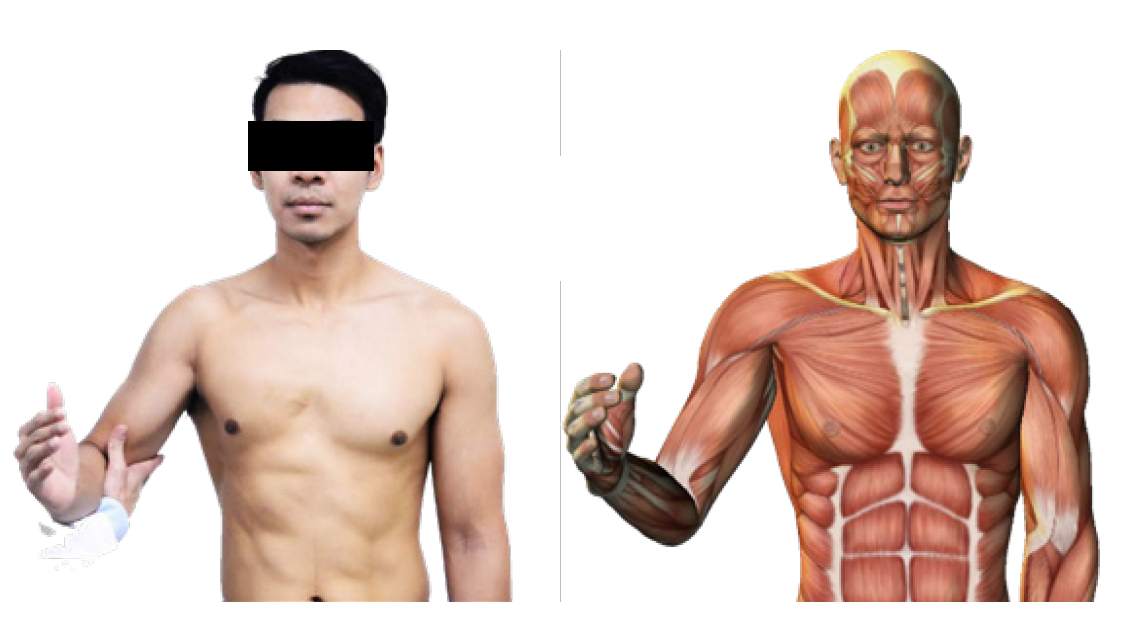Utilization of the Poser Program in Creating 3D Muscle Model in Medical Media Production
Main Article Content
Abstract
This article aimed to show guidelines for developing teaching materials using the 3D Poser program to create 3D muscle models for medical media. Currently, technological advancement of medical media has progressed at a continuous rate, which has resulted in medical education media playing a fundamental role. The 3D Poser program, as one of the variations of medical technology, is distinctive and specialized in visualization, particularly anatomy, and physiology. Therefore, the utilization of 3D programs in the production of medical media is deemed beneficial for complete and accurate medical imaging and modeling of human physiology. The 3D Poser program, though considered highly advanced in itself, is easy to operate and all but time consuming in the molding process of 3D parts. To aim for maximum anatomical accuracy and realistic illustration of the muscle graphics, it is necessary to use an add-on program or plug-in called Anatomy 4 Pro Bundle for texture mapping techniques and editing tools for adjusting, bending, posting, and rendering the model as desired. This technology creates future possibilities for the 3D Poser program to be a complement, if not foundation, of developing materials for medical training in the near future.
Article Details

This work is licensed under a Creative Commons Attribution-NonCommercial-NoDerivatives 4.0 International License.
References
กสิณ รังสิกรรพุม. การวิเคราะห์ปัจจัยในการผลิตสื่อการสอนทางการแพทย์จากการพิมพ์แบบเพิ่มขึ้น ด้วยกระบวนการลำดับชั้นเชิงวิเคราะห์. วารสารวิจัย มข. (ฉบับบัณฑิตศึกษา) 2564;21(1):133-44.
จิรัญดา กฤษเจริญ. การประยุกต์ใช้ Augmented Reality เพื่อการเรียนการสอนกายวิภาค. ศรีนครินทร์เวชสาร 2563; 35(1):99-102.
ทิศนา แขมมณี. การสอนจิตวิทยาการเรียนรู้ เรื่องศาสตร์การสอนองค์ความรู้เพื่อการจัดกระบวนการเรียนรู้ที่มีประสิทธิภาพ. พิมพ์ครั้งที่ 5. กรุงเทพฯ: สำนักพิมพ์แห่งจุฬาลงกรณ์ มหาวิทยาลัย; 2550.
ปณิธิ แก้วสวัสดิ์. สร้างและการจัดการแบบจำลอง 3 มิติ ด้วยโปรแกรม Maya 2017. กรุงเทพฯ: สำนักพิมพ์ ซีเอ็ดยูเคชั่น; 2560.
ปิยะ นากสงค์. สร้างงาน 3D และแอนิเมชันด้วย 3Ds Max 2018. กรุงเทพฯ: สำนักพิมพ์ ซิมพลิฟาย; 2561.
มาโนทย์ ปรีชานันท์, นิดาพรรณ สุรีรัตนันท์, ศิริพร ธิติเลิศเดชา. การบูรณาการกายวิภาคศาสตร์และการนําเสนอแบบ 3 มิติกับท่าพื้นฐานฤาษีดัดตน. ใน: เอกสารประกอบการประชุมเสนอผลงานวิจัย ระดับบัณฑิตศึกษาแห่งชาติครั้งที่ 14. กรุงเทพฯ: มหาวิทยาลัยเทคโนโลยีพระจอมเกล้าพระนครเหนือ; 2552.
รำแพน พรเทพเกษมสันต์. กายวิภาคศาสตร์และสรีรวิทยาของมนุษย์. กรุงเทพฯ: สำนักพิมพ์ ศิลปาบรรณาคาร; 2556.
วรัฏฐา เหมทอง และ วีรยุทธ ศรีทุมสุข. ผลของการใช้ภาพเคลื่อนไหวสามมิติต่อผลสัมฤทธิ์ทางการเรียนวิชากายวิภาคศาสตร์ระบบหัวใจของนักศึกษาวิทยาศาสตร์สุขภาพ. วารสารมหาวิทยาลัยคริสเตียน 2563;26(1):94-103.
กนกพรรณ วงศ์ประเสริฐ. สาระสำคัญกายวิภาคศาสตร์ของมนุษย์ เล่ม 1. กรุงเทพฯ: สำนักพิมพ์ ภาควิชากายวิภาคศาสตร์ คณะวิทยาศาสตร์ มหาวิทยาลัยมหิดล; 2555.
สรชัย ชวรางกูร. การศึกษาเปรียบเทียบผลสัมฤทธิ์และความสนใจ ของนักเรียนช่วงชั้นที่ 2 ที่มีต่อการ์ตูนแอนิเมชันรูปแบบ 2 มิติและ 3 มิติ. วิทยานิพนธ์ครุศาสตรอุตสาหกรรมมหาบัณฑิต สาขาวิชาเทคโนโลยีคอมพิวเตอร์, บัณฑิตวิทยาลัย สถาบันเทคโนโลยีพระจอมเกล้าพระนครเหนือ; 2550.
วรัทยา กุลนิธิชัย. การพัฒนาบทเรียนสื่อประสมเพื่อเสริมทักษะการเรียนรู้กายวิภาคศาสตร์ พื้นฐานระบบกระดูกของนิสิตพยาบาลศาสตร์ชั้นปีที่ 2 มหาวิทยาลัยพะเยา.วารสารพยาบาลทหารบก 2560;18(2):186-93.
Daz 3 D [Internet]. Daz Productions, Inc; [updated 2022 November 10; cited 2022 November 20] Available from: https://www.daz3d.com/






